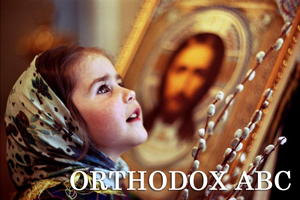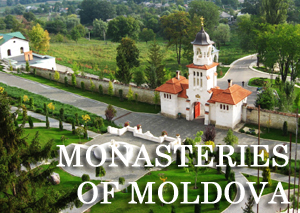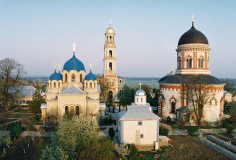
The monastery of the Holy Ascension in New-Neamts is situated in Bessarabia, on the right shore of Dniester, at a distance of 14 km from the town of Tighina (Bender) and 6 km from the town of Tiraspol. The monastic complex rises grandly to the sky, being seen from the distance by the people coming near the village of Chitcani.Gallery
There’re four churches on the territory of the monastery. In center of it, the wonderful Ascension cathedral is situated. On its left there is the old church built in the honor of the Saint Hierarch Nicholas the Wonder-Worker. Opposite there is a refectory church, of the Ascension of the Holy Cross. The Dormition church is a congruous part with its five chapels completing the general view of the monastery.
A real pearl of the monastery is the bell tower. Consisting of 5 levels, it is seventy meters tall and is the highest and the most splendid bell tower in the Republic of Moldova. From the upper level of the bell tower you can see the wonderful picturesque views of the surroundings. The golden chapel seems to call secretly each person, either a monk or just a passer-by, to raise the «mind to the sky» /Ps. 120, 1/.
Adminiring the wonderful picture of the halidom, let’s have a look at the past, at its history.
The Monastery in New-Neamts is the heir of the traditions of the orthodox Laura in Neamts, a religious and spiritual center of former Moldova. An important role in the history of the Laura in Neamts has had Reverend Paisie Velicicovski. This wonderful Saint revived on the Moldavian territory the spiritual dignity of a hegumen, implemented in the monastery of Neamts the status of a common life, «taught the believers» the prayer of Jesus. Being a big religious center, the Laura in Neamts owned enormous wealth: estates, cattle agricultural lands and other different goods, both in Moldova of the present-day Romainia, and in Bessarabia, donated to the holy halidom by the prince Alexandru cel Bun in 1429.
The Goverment of Alexandru Ioan Cuza takes the decision to subordinate the Orthodox Church of the state apparatus. The monasteries, amongst them the Laura of Neamts too, underwent a real robbery from the authorities by the monastery goods’ secularization law. The monk were pressed, and in the Laura community the status of the Reverend Paisie of Neamts was perpetrated. The permanent constraints determined many monks to leave in secret the Laura and to find refugee in Bessarabia, which, from 1812, was part of the Russian Empire.
Thus, the persecutions undergone by the Laura of Neamts in the ’50 of the 19th century lead to the foundation of a new monastery — New-Neamts. The estates of the monastery of Neamts in Bessarabia were managed then by father Theophan Cristea, the special delegate of the Laura — «… a learned man and full of fervor towards God and love towards people …».
Being very much upset by the news regarding the constraints in Romania, father Theophan submitted, short after that, a petition to the archbishop Antonie of Chisinau and Hotin, to the Holy Synod and even to the emperor Alexander II, with the request to create a new monastery on the estates in Bessarabia of the Laura of Neamts. Meanwhile, the ieromonk Theophan had correspondence with the spiritual father of Laura, the ieroschimonk Andronic, who had left the Laura of Neamts as well and secretly, came to Bessarabia. They defended the rule of Reverend Father Paisie, being the followers of the Saint Reverend’s followers, grew spiritually and strengthened with the source of the homilies of Saint Paisie. These two men, the ieromonk Theophan and schieromonk Andronic were the ones two founded the monastery of New-Neamts.
The Romanian goverment was trying, by all means, to hinder the foundation of the new monastery. The monks of New-Neamts had to undergo many hardships, but nothing could stop the fulfillment of this holy mission. The hight approval for the construction of the monastery of New-Neamts was issued on January 13, 1864. This date is considered the monastery’s foundation date.
32 monks from the Laura of Vechiul Neamts arrived to Chitcani. These settled down round the parish of «Saint Nicholas», enhancing their faith in prayer until the construction of the Ascension cathedral. The first monks who introduced into the new monastery the rule of the Reverend Paisie of Neamts.
Seeing the effort of father Theophan Cristea, the Brethren shoes him to be the hegumen of the monastery of New-Neamts (1864-1883). The copy of the icon of the Mother of God in Neamts was brought to the monastery. At the order of the hegumen, the renowned silversmith Verhovtev made the gold-plated silver cover for this icon, by the beauty of which he was himself astonished. This icon of the Mother of God named «New-Neamts» got famous later for a lot of wonders. The hegumen Theophan took care a lot of the monastery construction. At his insistence the cathedral in the honor of the Ascension (1867-1878). Colaboration affairs were created with other churches abroad: Jerusalem, the Holy Mount Athos, etc. Thus, in 1881 the Patriarch of Constantinopole, Joachim III, donated to the monastery in New-Neamts several parts of the holy remains, and in 1866, from the Patriarch of Jerusalem, Cyril II, the monastery receives: a gold-plated silver Cross, with a part of wood from the Holy Life-giving Cross of Lord the Savior; a part of the remains of the Saint Martyr Harlampy and of the Saint Modest, Patriarch of Jerusalem. Parts of the holy remains collected on March 28, 1882, are placed in a beautiful coffin made of gold-plated bronze.
In 1883 the hegumen Theophan passed away, leaving in stead of him the hieromonk Andronic (1885-1893). In this period new constructions of the monastery were built: the refectory, the hospital and the library. In 1884 the monastery library had 146 manuscripts in Slavic and Moldavian, 2272 books typed in the languages: Slavic, Moldavian, Russian, Greek etc. Father Andronic endowed to the library of New-Neamts over 60 works written by his hand, some of which being: «History for the Holy Monasteries Neamts and Secu» in 10 volumes and «History for the New Monastery of Neamts» in 2 volumes. With these and other works, the hieromonk Andronic, is amongst the first researchers of the work of the hegumen Paisie of Neamts. He is called the «the last chonicler of the 19th century».
After the death of the archimandrite Andronic, the hegumen of the monastery became father Germanus, (1893-1920) – «the embellisher of the New-Neamts halidom». At the initiative of the hegumen Germanus the Dormition Church (1902-1905) and wonderful bell tower (1913-1914) were built.
The monastery is famous not only for its buildings and wealth, but for its important role for the people’s spiritual education, too. Since 1900 on the territory of the monastery had activated a missionary center for the fight against heresy and sects.
Throughout the history of the monastery there have been painful moments, too, but with Lord’s help could be overcome. In 1940, the teritory of Bessarabia was occupied by the soviet people, who began a total antireligious propaganda. The monastery overcame difficulty the trials brought both by the second world war and by the post-seviet period.
In 1962 the monastery was closed. For 28 years the monastery has been transformed into a hospital of infectious diseases, and the bell tower into a museum of the German-Soviet war.
In 1990 the Monastery recommenced its usual activity. The care for the reconstruction and embellishment of the halidom was taken by his Eminence Vichentie, archbishop of Bender (then archbishop of Ekaterinburg and Verhotursk) and by the hegumen — archimandrite Dorimedont, then bishop of Edinet and Briceni.
Thanks to the efforts made in the period between 1999-2000 the church life was reconstituted, the monastery churches, the bell tower, the cells were repaired. At present there are being built new edifices. Near the monastery, a new church was built in the honor of the Reverend Paisie of Neamts, who is also the patron of the Monastery of New-Neamts.
At a distance of 6 km from it, at the border of Chitcani village, the monastery founded in 1993 a skete in the honor of the Holy Martyrs Vichentie and Dorimedont.
The inhabitants of the monastery enjoy both the splendid aspect of the constructions and the high spiritual life persisting in this halidom.
During 1990-2001 the monastery hosted the Theological Seminary of Chisinau, where many priests from Moldova, the Ukraine and Romania have studied.
In 1995, in the place of the former vestiary and the old library, a museum with two halls was opened. One of them is meant for keeping icons of the 18th – 20th cent., crosses, jubilee church medals, coins etc, and the second for keeping photographs from the foundation of the monastery up to the present, old books, robes etc.
The Lord showed His Mercy returning to the monastery the coffin with the remains of such great saints of Christianity as: Apostles Andrei, Luca, Toma, Filimon; of the saints Three Hierarchs; of the great Martyrs Gheorghie, Panteleimon, Teodor Stratilat and others, amounting to 170 Saints and a part of the Savior. The copy of the icon of the Mother of God of «New-Neamts» returns home.
In 1994 the monastery received as a gift a scepter of Reverend Paisie, and in 1997, at the insistence of archimandrite Dorimedont, a new coffin with parts of remains was made, especially of the Saint Reverends of Laura of Pecerska in Kiev. These and many other holy things are carefully kept by the lay brothers of the monastery.
Since 1995 the saint archimandrite of the monastery becomes the Metropolitan of Chisinau and of the whole Moldova, Vladimir.
The current hegumen of the monastery is the archimandrite Paisie (Cecan), who permanently takes care of the community of monk and lay brothers, sowing around peace and love and keeping the order in the halidom.
Bless Lord the halidom of New-Neamts.
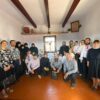 Memorial house of romanian elder Sofian Boghiu Consecrated in his native Village
Memorial house of romanian elder Sofian Boghiu Consecrated in his native Village 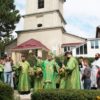 On the 14th Sunday after Pentecost, His Eminence Metropolitan Vladimir celebrated the Divine Liturgy in the St. Nicolas Monastery, Dobrusa village, Soldanesti region
On the 14th Sunday after Pentecost, His Eminence Metropolitan Vladimir celebrated the Divine Liturgy in the St. Nicolas Monastery, Dobrusa village, Soldanesti region 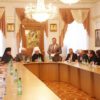 Inauguration of the volume of articles presented at the National Scientific Conference “The Orthodox Church and the State: Faith and Knowledge”
Inauguration of the volume of articles presented at the National Scientific Conference “The Orthodox Church and the State: Faith and Knowledge” 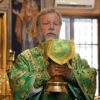 The 12th Sunday after Pentecost – kindness in God changes the world we live in
The 12th Sunday after Pentecost – kindness in God changes the world we live in 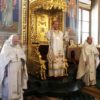 The 11th Sunday after Pentecost – loving our God and our neighbor
The 11th Sunday after Pentecost – loving our God and our neighbor 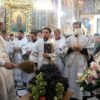 The Transfiguration of the Lord, celebrated in the Nativity of the Lord Cathedral in Chisinau
The Transfiguration of the Lord, celebrated in the Nativity of the Lord Cathedral in Chisinau 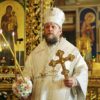 His Eminence Metropolitan Vladimir celebrates 65th anniversary
His Eminence Metropolitan Vladimir celebrates 65th anniversary  Divine Service at the St. Theodore of Tyre Monastery (Ciuflea) in Chisinau, and congratulation of Archimandrite Nicolae (Rosca), the Monastery’s confessor-administrator, on the 50th anniversary.
Divine Service at the St. Theodore of Tyre Monastery (Ciuflea) in Chisinau, and congratulation of Archimandrite Nicolae (Rosca), the Monastery’s confessor-administrator, on the 50th anniversary.  The Tenth Sunday after Pentecost: Divine Liturgy in the Nativity of the Lord Cathedral in Chisinau
The Tenth Sunday after Pentecost: Divine Liturgy in the Nativity of the Lord Cathedral in Chisinau 
